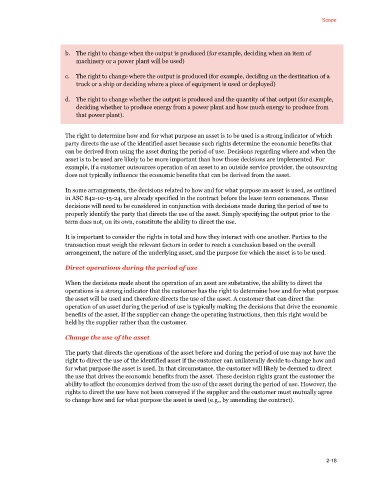Page 39 - pwc-lease-accounting-guide_Neat
P. 39
Scope
b. The right to change when the output is produced (for example, deciding when an item of
machinery or a power plant will be used)
c. The right to change where the output is produced (for example, deciding on the destination of a
truck or a ship or deciding where a piece of equipment is used or deployed)
d. The right to change whether the output is produced and the quantity of that output (for example,
deciding whether to produce energy from a power plant and how much energy to produce from
that power plant).
The right to determine how and for what purpose an asset is to be used is a strong indicator of which
party directs the use of the identified asset because such rights determine the economic benefits that
can be derived from using the asset during the period of use. Decisions regarding where and when the
asset is to be used are likely to be more important than how those decisions are implemented. For
example, if a customer outsources operation of an asset to an outside service provider, the outsourcing
does not typically influence the economic benefits that can be derived from the asset.
In some arrangements, the decisions related to how and for what purpose an asset is used, as outlined
in ASC 842-10-15-24, are already specified in the contract before the lease term commences. These
decisions will need to be considered in conjunction with decisions made during the period of use to
properly identify the party that directs the use of the asset. Simply specifying the output prior to the
term does not, on its own, constitute the ability to direct the use.
It is important to consider the rights in total and how they interact with one another. Parties to the
transaction must weigh the relevant factors in order to reach a conclusion based on the overall
arrangement, the nature of the underlying asset, and the purpose for which the asset is to be used.
Direct operations during the period of use
When the decisions made about the operation of an asset are substantive, the ability to direct the
operations is a strong indicator that the customer has the right to determine how and for what purpose
the asset will be used and therefore directs the use of the asset. A customer that can direct the
operation of an asset during the period of use is typically making the decisions that drive the economic
benefits of the asset. If the supplier can change the operating instructions, then this right would be
held by the supplier rather than the customer.
Change the use of the asset
The party that directs the operations of the asset before and during the period of use may not have the
right to direct the use of the identified asset if the customer can unilaterally decide to change how and
for what purpose the asset is used. In that circumstance, the customer will likely be deemed to direct
the use that drives the economic benefits from the asset. These decision rights grant the customer the
ability to affect the economics derived from the use of the asset during the period of use. However, the
rights to direct the use have not been conveyed if the supplier and the customer must mutually agree
to change how and for what purpose the asset is used (e.g., by amending the contract).
2-18

